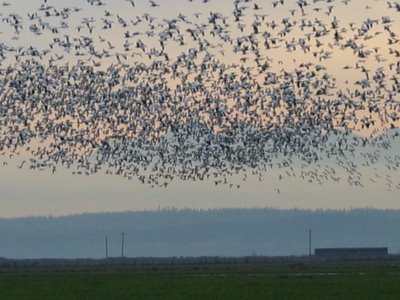
“Generations know Mount Hood as a landmark for the ages, with an icy crown of gleaming glaciers that supply the streams we drink from, catch fish in and grow food with,” writes Michael Milstein in The Oregonian this Sunday. “It is our playground, retreat and beacon on the horizon. It is Oregon.”
Unfortunately for all Hood-lovin’ Oregonians, the volcano is rapidly shedding its cloak of glaciers—the seven largest glaciers on her flanks have shrunk nearly 35% since the beginning of the 20th century due to global warming. And the University of Washington’s Climate Impacts Group believes the Pacific Northwest will heat up as much in the next 20 years as it did in the past 100.
Bad news for salmon, for skiers, for the Hood River farmers who depend on the mountain’s glacial fresh water run-off in the summer to water their crops of apples, pears, hops and grapes. The glaciers gush somewhere in the neighborhood of 4 billion gallons of water a year, feeding irrigation, keeping creeks and rivers cool for fish and creating hydropower that provides electricity for the entire region.
Other interesting facts in Milstein’s “Mount Hood Meltdown” report:
* “Pacific Northwest glaciers have contributed about 17 percent of the icemelt outside Greenland and Antarctica that is credited with raising ocean levels from 1961 to 2003.”
* “Sandy Glacier, on Mount Hood's west slopes facing Portland and a headwaters of the Sandy River, covers about 60 percent less ground than it did a century ago.”
and
* “The past decade in the Northwest was the warmest on record. Average low temperatures at Eliot Glacier have been above freezing during at least six of the last 12 years -- more than any such period in the last 110 years.”
Milstein also points out the painfully obvious: “There is wide agreement among scientists that human burning of fossil fuels has driven greenhouses gases to their highest levels in at least 600,000 years, warming the Earth especially during the last few decades and speeding the glaciers' demise.”
Some scientists predict Hood will be glacier-free in as little as 180 years, “leaving Oregonians a view of slick, gray rock.” If you’ve got the stomach for bad news, read the rest here.
Elsewhere in Ish River Country, while King George and his lil’ cowpokes in the Capitol cluelessly fiddle (“Global warming? What, me worry?), Seattle is aggressively pursuing the goals of the Kyoto Treaty in reducing greenhouse gas emissions, joining 218 other US cities that, in the face of federal inaction, are taking the lead on the issue. A report, commissioned by Seattle mayor Greg Nickels and crafted in part by Earth Day founder Dennis Hayes and retired Starbuck’s CEO Orin Smith, recommends “spending millions more on transit, building more compact neighborhoods, encouraging energy efficiency and using more fuels from plants rather than petroleum.” You can find out more about Seattle’s visionary goals in this article in the Seattle Times. Al Gore was just in the Jet City to help hype the plan—commentary on his impressive powerpoint (and oratory) skills here in the Cascadia Scorecard blog. The official City of Seattle strategy is here.
And finally, a fascinating photographic survey of retreating glaciers and other visible effects of global warming can be found right here.
global warming
glaciers
Mt. Hood
Seattle
















